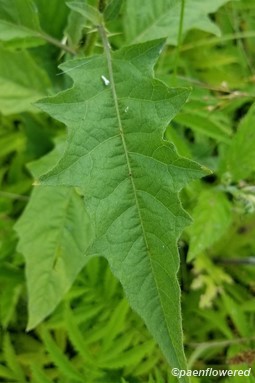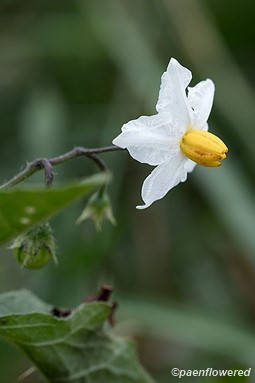Solanum carolinense
A non-native weed with attractive lavender star-like flowers
Solanum carolinense Carolina horse-nettle
This member of the tomato or nightshade family (Solanaceae) has established in eastern North America but has spread to other locations. It is documented in almost all of the counties of Pennsylvania. It can grow up to three or four feet high, but it is often lower and more spreading. It grows in sandy soil and is common in fields, and along roads. Although the stem has yellow prickles, it is not a true nettle - little comfort to the gardener who tries to grab one.
The flowers are similar in form to the nightshade plant, but larger with wider lobes. The attractive flower is star-like in shape with five white or lavender petals and yellow elongated anthers forming a central cone. The flower is ¾ to 1 ¼ inch in diameter and blooms from May until October. Bumblebees visit the flowers to collect pollen.
The 3-5 inch hairy leaves are rough and widely toothed or lobed. The fruit is a tomato-like berry about ¾ of an inch in diameter that turns from green to yellow as it matures. Each fruit contains about sixty seeds. All parts of the plant, particularly the unripe fruit, can be deadly poisonous; this is due to the presence of alkaloid toxins. Several types of animals can eat the mature fruit - helping to distribute the seeds.
The horse-nettle is considered a noxious weed in some western states as well as Alaska and Hawaii and by many local gardeners. Cattle will not eat it and it is difficult to eradicate due to a deep taproot and an underground stem called a rhizome. It also tends to be resistant to herbicides and may actually grow more once competitive plants are removed. Gloves are needed to pull the plant up by hand.
The horse-nettle is beneficial in that it provides ground cover for a number of predatory beetles that kill insect pests. It is also called by a number of local names including: radical weed sand briar, bull nettle, treat-softly, and apple of Sodom.
Habitat & Range
Grows in meadows, fields, sandy stream banks, and man-disturbed habitats.
Present throughout the state.
Range: Found in the eastern part of the US.
| EMP: | FACU |
|---|---|
| NCNE: | FACU |
Phenology
Flowers from June to September.
Identification Tips
Has sharp spines on leaves and stems.
Plant Codes
S-rank: No rank
G-rank: G5 (Secure)











Comments
Have you spotted this plant in your area? We'd love to hear about your experience! Share your comments or questions about the plant below. Comments are moderated before posting.